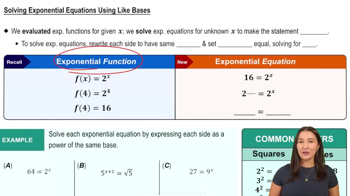Table of contents
- 0. Review of Algebra4h 16m
- 1. Equations & Inequalities3h 18m
- 2. Graphs of Equations43m
- 3. Functions2h 17m
- 4. Polynomial Functions1h 44m
- 5. Rational Functions1h 23m
- 6. Exponential & Logarithmic Functions2h 28m
- 7. Systems of Equations & Matrices4h 6m
- 8. Conic Sections2h 23m
- 9. Sequences, Series, & Induction1h 19m
- 10. Combinatorics & Probability1h 45m
6. Exponential & Logarithmic Functions
Solving Exponential and Logarithmic Equations
Problem 68
Textbook Question
Textbook QuestionIn Exercises 64–73, solve each exponential equation. Where necessary, express the solution set in terms of natural or common logarithms and use a calculator to obtain a decimal approximation, correct to two decimal places, for the solution. 8^x = 12143
 Verified Solution
Verified SolutionThis video solution was recommended by our tutors as helpful for the problem above
Video duration:
2mPlay a video:
Was this helpful?
Key Concepts
Here are the essential concepts you must grasp in order to answer the question correctly.
Exponential Equations
Exponential equations are mathematical expressions in which a variable appears in the exponent. To solve these equations, one typically seeks to isolate the variable by using properties of exponents or logarithms. For example, in the equation 8^x = 12143, the goal is to express x in a form that can be calculated, often by taking the logarithm of both sides.
Recommended video:

Solving Exponential Equations Using Logs
Logarithms
Logarithms are the inverse operations of exponentiation, allowing us to solve for exponents in equations. The logarithm of a number is the exponent to which a base must be raised to produce that number. In the context of the equation 8^x = 12143, one would use logarithms to rewrite the equation as x = log_8(12143), which can be further simplified using the change of base formula.
Recommended video:

Logarithms Introduction
Calculator Use for Approximations
Using a calculator to obtain decimal approximations is essential when dealing with logarithmic values that do not yield simple fractions. After determining the logarithmic expression for x, a calculator can provide a numerical approximation, which is often required in practical applications. For instance, after calculating log_8(12143), one would use a calculator to find the decimal value of x, rounding it to two decimal places as specified.
Recommended video:

Solving Exponential Equations Using Logs

 4:46m
4:46mWatch next
Master Solving Exponential Equations Using Like Bases with a bite sized video explanation from Callie
Start learningRelated Videos
Related Practice












